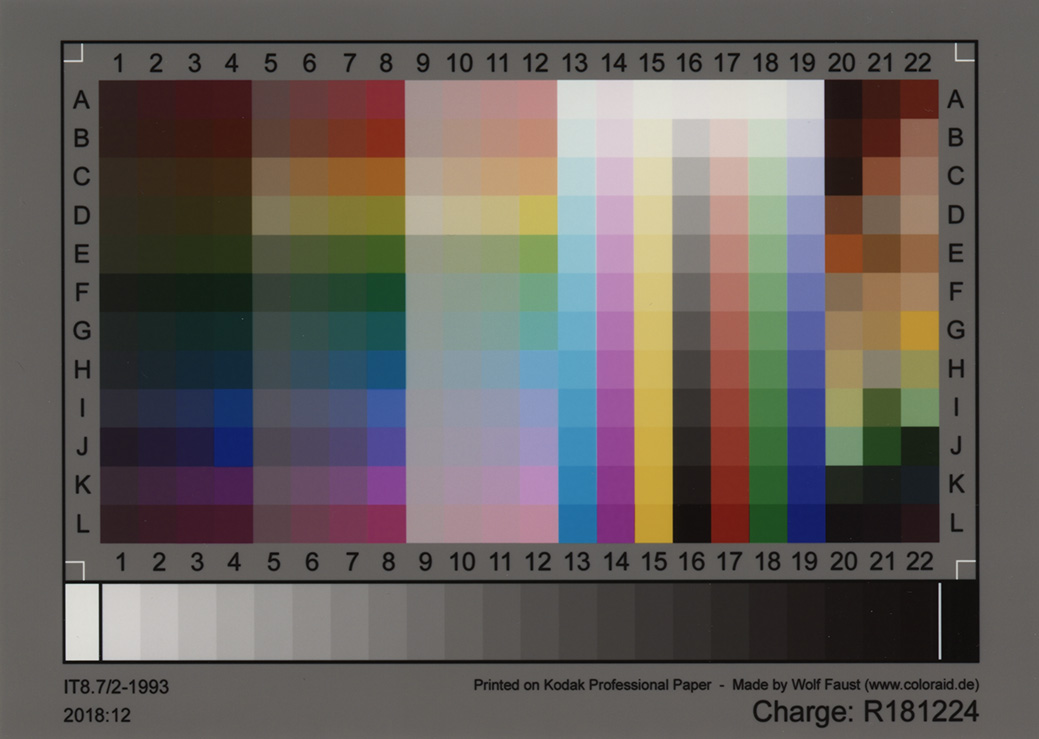This is an old revision of the document!
How To Calibrate for IT8
The first step to calibration is getting a scan of your IT8 card. If you have gone through the Software part of the guide,you should be able to use Canon, Epson, or Vuescan scanning software to get a “flat” scan of your card. 400-600DPI are recommended as the calibration software sometimes has issues with high resolution scans at 800DPI or higher. Crop around the card so there’s no white space. If you crop into the card a bit it’s okay as long as it’s within the initial grey border. Also make sure you're scanning the card and that you remove it from the protective sleeve as some people have scanned it while it was still in the sleeve which you don't want to do.
The biggest key to this is to scan your IT8 target in exactly the same way you plan to scan your boxes/manuals etc. So if you’re planning on using Epson Scan and scanning in 24-bit, you’ll need to scan your IT8 target with the exact same settings. If you’re planning on doing 48-bit sometimes as well then you’ll need to scan and calibrate a separate file for that. It’s really up to how you want to do it. For most users just one calibration file will be all that’s needed because you’ll likely always use the same settings and software when scanning.
Your scan should look similar to this image:
Now that you a scan of your card you need to run it through calibration software and our recommendations will differ depending on your operating system but they all use the same calibration software underneath called ArgyII.
Windows Solutions
Our recommended Windows solution is a software called CoCa which you can download here. It's fairly easy to use and produces great profiles! So go ahead and download and install that. You'll also need to download and unzip the ZIP file tied to the Charge Number in the lower right corner of your IT8 card if you ordered it from our recommended vendor here. Scroll to the bottom of that page and look for your charge number and download and extract the ZIP file. You'll need the .txt file with the same Charge Number from this for calibration. Now go ahead and open the CoCa software up and it will look similar to this.
Now I'll go over each section and what you should do in them.
Target Image - Click the select button and browse for the scan of your IT8 card and select it.
Reference File - Click the Custom button in this section and browse to the place you unzipped the Charge file ZIP you downloaded earlier. Select the .txt file with your charge number that should be located in the extracted folder from the ZIP file. For example on my card it was called “R181224.txt”.
Profile Information - Optional but I recommend filling this out with descriptive information, especially if you are going to do multiple profiles (Say one for 24-bit and one for 48-bit etc.) The field that you'll actually see when you go to select your profile is the Internal Profile Description. You can see in the example that I typed in my Scanner Model, the software I used (Epson Scan) and the bit depth. I'd recommend doing something similar.
Corrections - You shouldn't need to adjust this unless you scanned your IT8 card in Vuescan in 48-Bit RAW mode. If you do that your scan will be VERY dark and that means your Gamma is 1.0. You'll need to change the Gamma to 2.2 to 1.0 if you did that, otherwise leave it at 2.2.
Select Target Type - Pick IT8.7 here.
Options - Select Display XYZ cLUT + matrix as your algorithm, Default Intent I pick Absolute Colorimetric here as I commonly use that when I convert my images to SRGB but Relative is fine here too. Quality I would set it to High.
After you've set your options like that click the Create Profile button. You'll see a black box pop up and it will process a bunch of stuff. Once it's finished if everything went okay you should get a Save dialog box. Make sure you save your profile to C:\Windows\System32\spool\drivers\color as that's where Windows looks for IT8 profile. Once that is finished you're done and you now have an IT8 profile you can attach to your scans in your image editing program of choice. Congrats!

